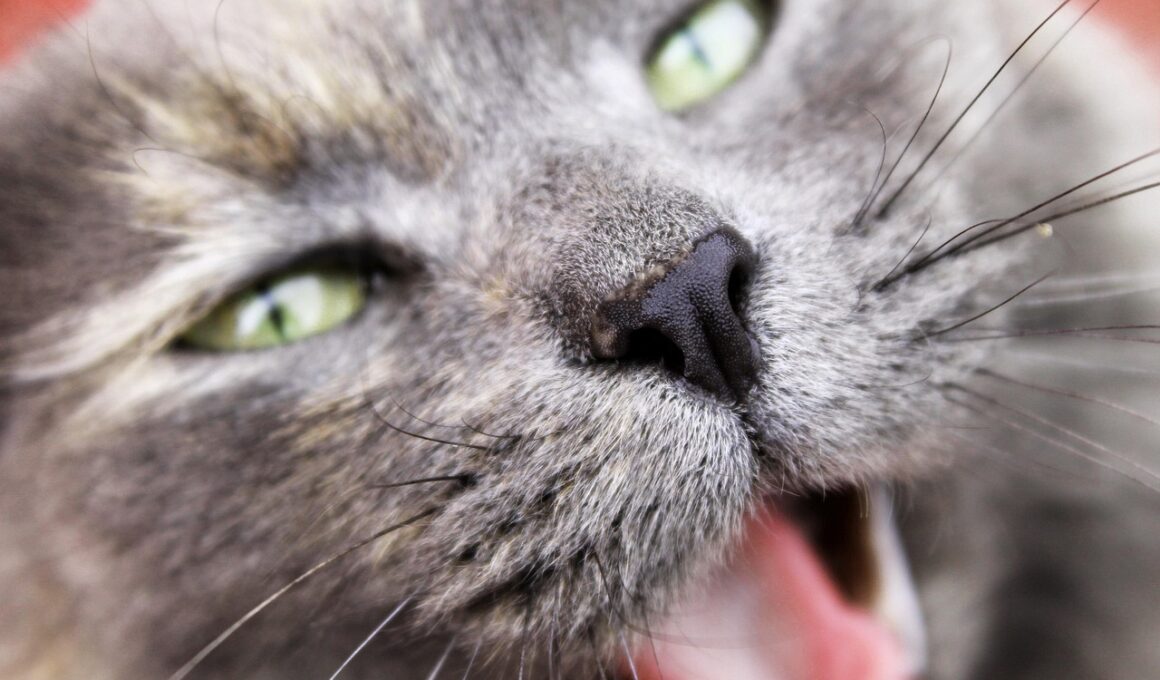How Stress Triggers Aggression in Cats
Aggression in cats can often be a sign of underlying stress or anxiety. Understanding how stress impacts feline behavior is crucial for pet owners. Various factors contribute to stress in cats, including changes in environment and routine. When a cat feels threatened or anxious, it may resort to aggressive behaviors as a coping mechanism. Factors such as loud noises, new pets, or even changes in household dynamics can trigger this stress response. Moreover, aggression can be a direct result of fear, often leading to defensive actions. If a cat feels cornered or unable to escape, it may lash out. Recognizing signs of stress is essential for addressing the behavior effectively. Observing the cat’s body language, such as flattened ears or a twitching tail, can provide insight into its emotional state. Owners must create a safe and stable environment to help reduce anxiety levels. Taking proactive steps to minimize stress can have a significant impact on a cat’s overall behavior. Regular playtime, safe spaces, and calming products can help mitigate aggressive tendencies and promote a relaxed atmosphere within the household. Appropriate interventions make a difference.
Another aspect to consider is how changes in diet and routine affect a cat’s stress levels. Cats are creatures of habit, and alterations in their food schedule, litter box maintenance, or playtime can lead to feelings of insecurity. This shift can make them more susceptible to aggressive outbursts, as they don’t know what to expect. Additionally, certain food ingredients and changes in diet can have an impact on a cat’s mood and energy levels. For instance, diets lacking in essential nutrients can lead to irritability and unwanted behavior. Providing a consistent and balanced diet can help maintain a cat’s physical and emotional health. Ensuring hydration is crucial as well, since dehydration can affect mood and overall wellness. Creating a routine that includes regular feeding times and playtimes fosters a sense of security for your cat. You can also set up enriching environments that offer mental and physical stimulation. By doing this, you can lessen the chance of aggression stemming from boredom or excess energy. Establishing a feeding schedule that aligns with the cat’s natural instincts is also beneficial for its psychological state.
Environmental Factors Influencing Aggression
Environmental stimuli can play a significant role in a cat’s stress and aggression. Common triggers include unfamiliar noises, strangers in the home, or even the presence of other animals. Cats have heightened senses, making them sensitive to sounds and sights that might not bother humans. For example, loud music, sudden door knocks, or household commotion can create feelings of insecurity. Changes in the environment, such as moving furniture or introducing new scents, can also be a source of anxiety. It is essential for pet owners to observe their cats closely in these situations. Identifying specific triggers can lead to targeted interventions and adjustments in the environment. Providing a safe zone, such as a quiet room or a cozy bed where they can retreat, can significantly help. Additionally, using pheromone diffusers can create a calming atmosphere, reducing overall anxiety. Tailoring an environment to encourage security and comfort aids in minimizing triggers. Keeping the home consistent and stable enables cats to adjust better to changes when they happen. Creating a secure environment also has bonus advantages, like promoting positive interactions with family and other pets.
Social dynamics in the household can also trigger aggression in cats, specifically with the introduction of new pets or changes in human interactions. If a cat feels its territory is being invaded, it may act out aggressively. This behavior can be particularly intense if the new cat is perceived as a rival for attention or resources. It’s essential to gradually introduce new pets to reduce stress and anxiety. Implementing slow introductions and separate spaces initially can prevent territorial disputes. This approach gives both the existing cat and the newcomer time to adjust to the changes in their environment. Observing their reactions during the introduction phase will inform if further adjustments are necessary. Furthermore, establishing clear boundaries within the home can help maintain harmony. It’s crucial to create equal opportunities for attention among pets. Schedule individual play sessions and affection, ensuring that all pets feel loved and valued. If conflicts arise, providing opportunities for escape and safe spaces helps bridge social dynamics effectively. Addressing these factors head-on plays a vital role in curbing aggression caused by anxiety-related social issues among cats.
Behavioral Signs of Stress and Aggression
Monitoring your cat for behavioral signs of stress is crucial for addressing aggression effectively. Some evident signs may include hissing, growling, swatting, and changes in litter box habits. These behaviors often signal that a cat is feeling threatened or overwhelmed. Cats may also exhibit more subtle signs of discomfort, such as excessive grooming or hiding. Changes in appetite, lethargy, or sudden bursts of energy can also indicate anxiety levels. It’s important to understand these signs in the context of their environment. By recognizing patterns and environmental triggers, you can gain insight into what causes your cat to feel stressed. Accurate observation of changes is necessary for establishing a plan for intervention. Providing your cat with an enriched living environment can decrease the likelihood of stress-induced aggression. Interactive toys, puzzle feeders, and vertical spaces can help channel excess energy in more positive ways. Regular veterinary check-ups also ensure your cat’s well-being remains stable, allowing for earlier identification of health-related issues impacting behavior. Taking the time to observe your feline friend can foster a deeper understanding and stronger bond.
Another effective strategy for reducing aggression triggered by stress in cats involves practicing positive reinforcement techniques. Rewarding desirable behaviors such as calmness and playfulness through treats or affection encourages the repetition of these actions. Avoiding punitive measures is essential, as they can lead to increased anxiety and fearfulness. Instead, focus on redirecting aggressive behaviors into more constructive outlets. Regular training sessions can also promote the bond between you and your pet, establishing trust and improving communication. Consider working with a professional animal behaviorist to design a tailored behavior modification plan if needed. These experts can provide personalized strategies and insights based on your cat’s specific quirks and challenges. Furthermore, creating routines during playtime using specific toys can reinforce good behavior while providing essential exercise. An outlet for energy reduces aggressive tendencies, making sessions enjoyable for both you and your cat. Employing these positive techniques fosters a harmonious environment conducive to emotional well-being. Through careful observation and intentional practice, you can transform stress-induced aggression into positive interactions, ensuring a happier, healthier cat that feels secure and loved.
Conclusion: Maintaining Cat Well-Being
In conclusion, understanding how stress triggers aggression in cats is fundamental for promoting their overall well-being. By identifying the underlying causes of stress, pet owners can take specific steps to alleviate anxiety. Creating a peaceful home environment, recognizing stress signs, and implementing positive reinforcements are crucial components of reducing aggression. With patience and care, you can foster a secure atmosphere that diminishes stress levels significantly. This proactive approach enables you to enjoy a harmonious relationship with your cat, minimizing aggressive outbursts and enhancing their quality of life. Remember that addressing these behaviors takes time, as patience is key in modifying your cat’s responses to stress. Regular engagement, a stable routine, and nurturing surroundings contribute to overall emotional health. Providing enrichment opportunities also aids in channeling energy into positive behaviors, further reducing aggression. Furthermore, ensuring your cat has appropriate outlets for social interaction and personal space are vital. Seeking veterinary assistance for underlying health issues affecting behavior can’t be overlooked. Ultimately, prioritizing your cat’s emotional well-being leads to a happier, more contented companion you can cherish for years to come.
The final points to consider involve the ongoing commitment to understanding feline behavior. Continuous learning about your cat’s needs and responses further enhances your relationship. Keep in mind that every cat is unique, and generalizations may not apply universally. Monitoring individual reactions during stressors can provide valuable insights into your cat’s behavior patterns. Joining cat owner communities or forums is also beneficial for sharing experiences and gaining new tips. These platforms offer support and assistance from fellow owners who’ve faced similar challenges. Additionally, implementing regular assessments of your pet’s well-being keeps their environment optimal. Frequent check-ins on emotional and physical health can lead to more effective management of stress-related aggression. Remember, creating a loving and understanding atmosphere allows your cat to flourish. It is essential to continually adapt your strategy based on your observations and insights. Through consistent effort, both you and your cat can enjoy a more peaceful coexistence. This journey of learning fosters not only better behavior but also strengthens the bond shared between you and your feline companion. Embracing this opportunity for growth leads to mutual happiness and understanding.


